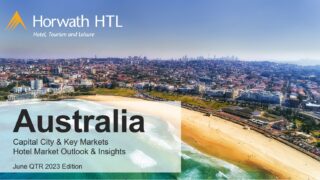Australia Key City Hotel Market Outlook June 2023 Edition
By Damien Little on 28. August 2023

This report by Horwath HTL in Australia provides an outlook for ten key city markets across Australia, assessing performance to June 2023 and the outlook for future growth.
The data as published in the report is based on the economic forecast by Deloitte Access Economics for the June 2023 quarter, historical hotel performance from STR as of June 2023, as well as historical tourism data available as of July 2023, including forecasted domestic and international visitation from Tourism Research Australia (TRA) as at December 2022 adjusted by Horwath HTL.
In the year ending June 2023, all key markets but Sunshine Coast have continued to record RevPAR growth compared to the same period in 2022. The Sunshine Coast market follows a trend of declining demand levels in leisure-dominant markets like Gold Coast and Hobart. Melbourne, which as of March 2023 was only about $2 away from the December 2019 RevPAR number, has inched to be effectively in line with the pre-COVID-19 RevPAR. Melbourne is the last of the ten key markets to match or exceed the pre-COVID-19 RevPAR.
ADR growth levels are moderating across the country. After the double-digit growth in ADR recently, we have seen all markets return to single-digit growth rates or declining ADR levels. Adelaide, Brisbane, and Perth are the only markets that have not recorded even one month of decline in ADR. This trend is not unexpected, given the significant increases seen over the last 12 to 18 months. However, the question remains about how much of an ADR correction we might see or will the markets experience some stabilisation before returning to a growth pattern.
The continued return of corporate travel and the return of international visitors has seen the continued slow improvement in performance for the Melbourne and Sydney markets. The pace of recovery for both cities is remarkably similar regarding the volume of room night demand and room revenue. However, the key difference between the two markets is the far larger volume of new supply that Melbourne needs to absorb, which is keeping occupancy recovery for Melbourne lower, impacting the pace of RevPAR recovery.
After two unconventional years when the seasonality was disrupted, in 2023 we have seen the return of seasonal demand patterns. Over the second half of 2023, the new normal regarding seasonal occupancy and ADR levels will become more evident.